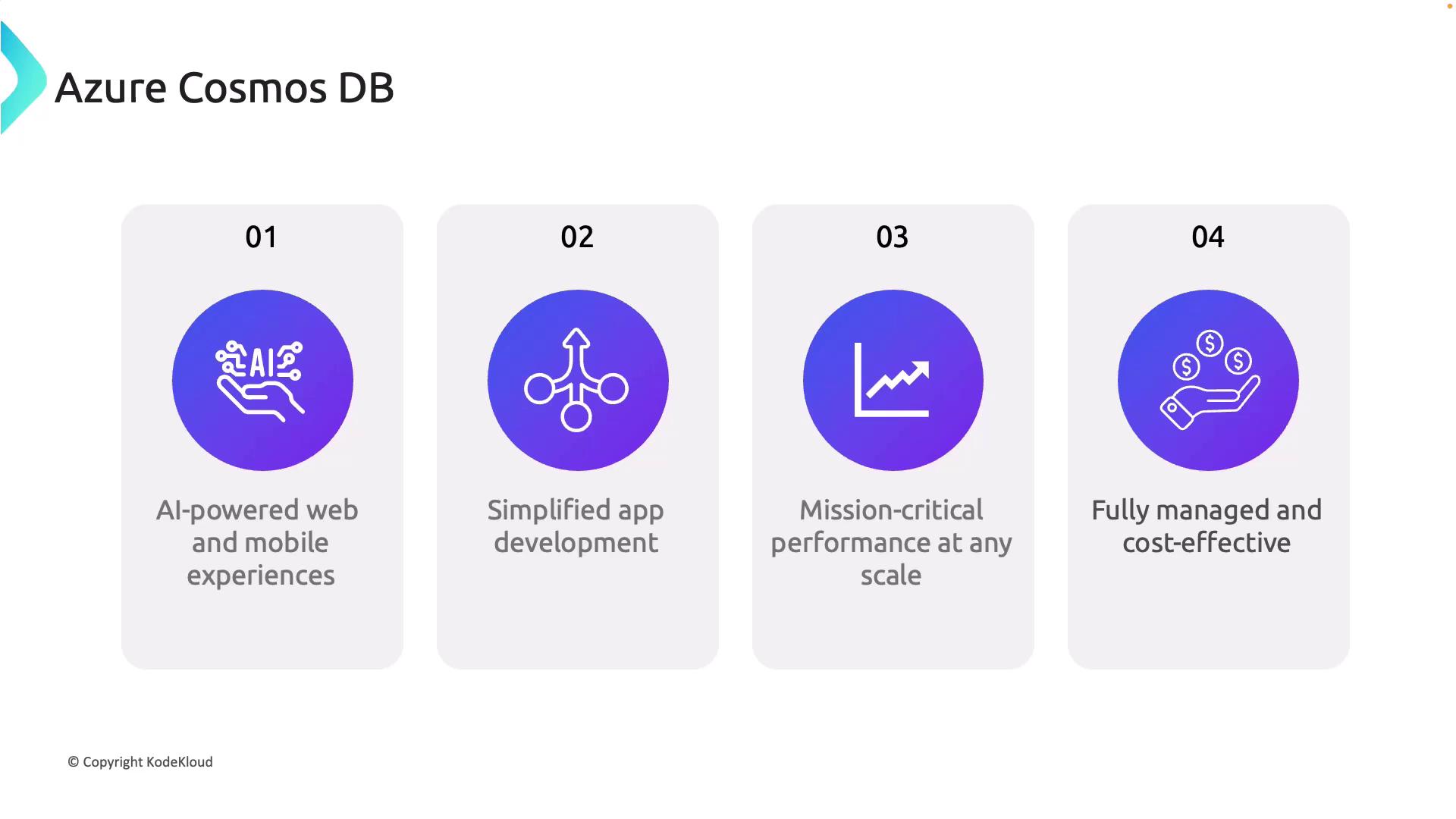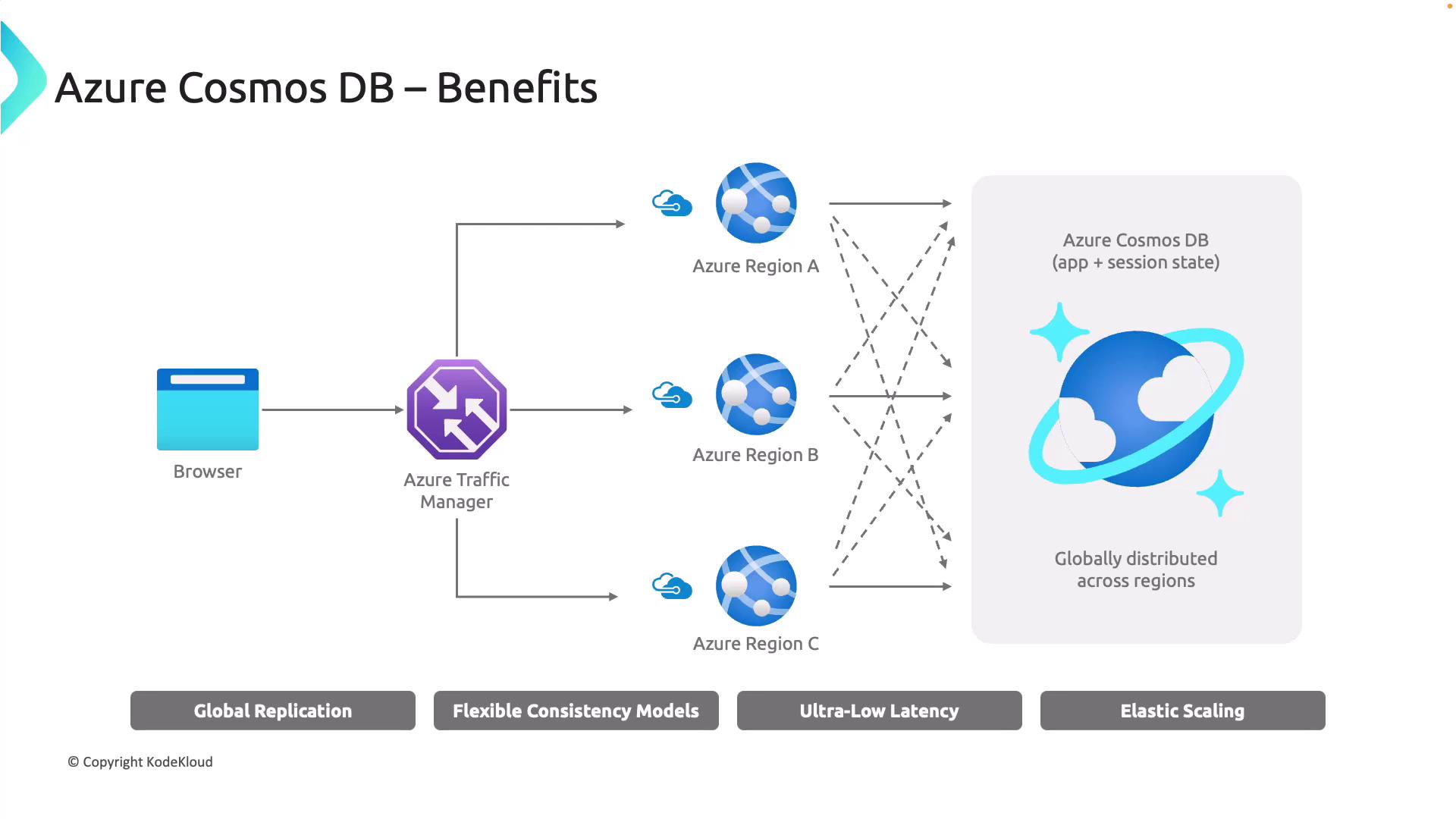AZ-204: Developing Solutions for Microsoft Azure
Exploring Azure Cosmos DB
Exploring Azure Cosmos DB
Azure Cosmos DB is Microsoft's globally distributed, multi-model database service designed for modern, scalable applications. It empowers developers to build low-latency, high-availability solutions across the globe with mission-critical performance. This guide covers its key features, benefits, and architectural insights.
AI-Powered Web and Mobile Experiences
Azure Cosmos DB enables the creation of responsive, AI-driven web and mobile applications with a global reach. By distributing data across multiple regions, Cosmos DB ensures low latency and high availability, making it the perfect solution for real-time applications. For instance, a global e-commerce platform can utilize Cosmos DB to deliver fast product recommendations and chatbot interactions no matter where the user is located.
Simplified App Development
Designed to simplify application development, Cosmos DB supports a variety of APIs, including SQL, MongoDB, Cassandra, PostgreSQL, and Gremlin. This multi-model approach allows developers to integrate familiar tools and languages, reducing the complexity of managing distributed data. Whether your data is relational, key-value, graph, or document-based, Cosmos DB offers a streamlined development process.
Mission-Critical Performance at Any Scale
Azure Cosmos DB is engineered to deliver consistent performance—even during traffic spikes. With features like global replication and dynamic scaling, it handles thousands to millions of requests simultaneously. For example, a global social media application can rely on Cosmos DB to efficiently manage sudden surges in user activity without sacrificing performance.
Fully Managed and Cost-Effective
As a fully managed service, Azure Cosmos DB handles infrastructure tasks such as patching and scaling, allowing developers to focus on building innovative applications. Its pricing model, based on Request Units (RUs), ensures you only pay for the resources you use. This cost-effectiveness makes Cosmos DB suitable for organizations of all sizes—from startups to large enterprises.

Architectural Overview and Benefits
Visualize a scenario where a browser connects to various app services via Azure Traffic Manager—a DNS load balancing solution. Instead of managing multiple databases for each app service, a single Azure Cosmos DB backend can serve them all with multi-region read and write support. This global replication enables users to access data from the closest location, thereby improving performance and reliability.
Global Replication
Cosmos DB distributes data across various regions, reducing latency by connecting users to the nearest data center. This global replication not only enhances application responsiveness but also safeguards against regional outages.
Note
Azure Cosmos DB's replication strategy is especially beneficial for users distributed around the world. A user in Europe, for example, benefits from data served from a local European region.
Flexible Consistency Models
Cosmos DB provides five distinct consistency models:
- Strong
- Bounded Staleness
- Session
- Consistent Prefix
- Eventual Consistency
These models allow developers to balance the trade-offs between consistency, availability, and performance. Mission-critical applications may require strong consistency to ensure data integrity, while less critical use cases might benefit from the speed of eventual consistency.
Ultra-Low Latency
Designed for real-time applications, Cosmos DB offers sub-10 millisecond response times for both read and write operations. This ultra-low latency is crucial for applications like online gaming and live financial trading, where even slight delays can have a significant impact.
Elastic Scaling
Azure Cosmos DB supports both manual and automatic scaling, quickly adapting to varying workloads. Its elastic scaling capability is perfect for scenarios such as e-commerce websites, which may experience heavy traffic during flash sales or special promotions.

Conclusion
Azure Cosmos DB stands out as a robust platform for developing globally distributed, mission-critical applications. Its features—global replication, flexible consistency models, ultra-low latency, and elastic scaling—offer developers the versatility to build high-performance solutions that meet diverse business needs.
In the next module, we will take a closer look at the hierarchical structure of Azure Cosmos DB and explore its inner workings.
Stay Informed
For more insights on Azure Cosmos DB and other Microsoft Azure services, be sure to follow our upcoming modules and detailed guides.
Watch Video
Watch video content